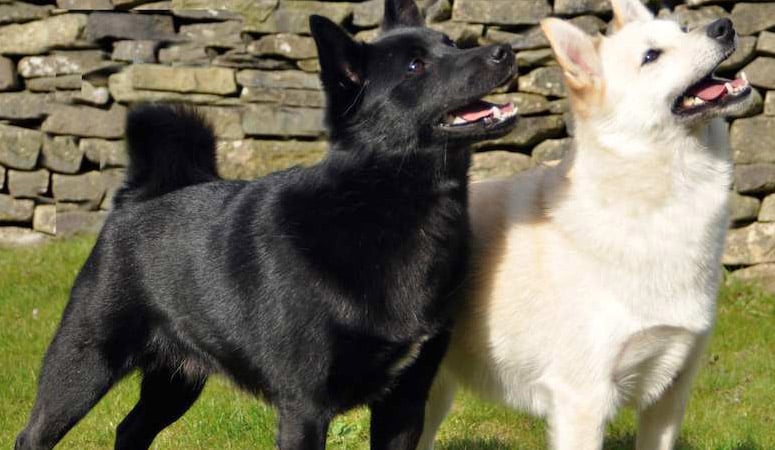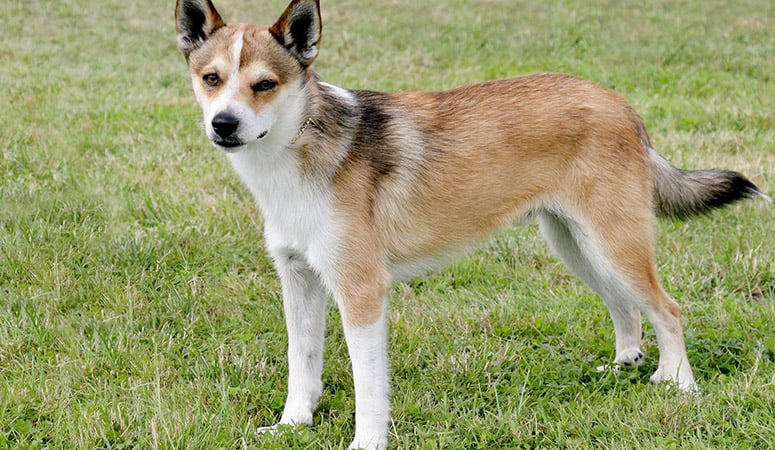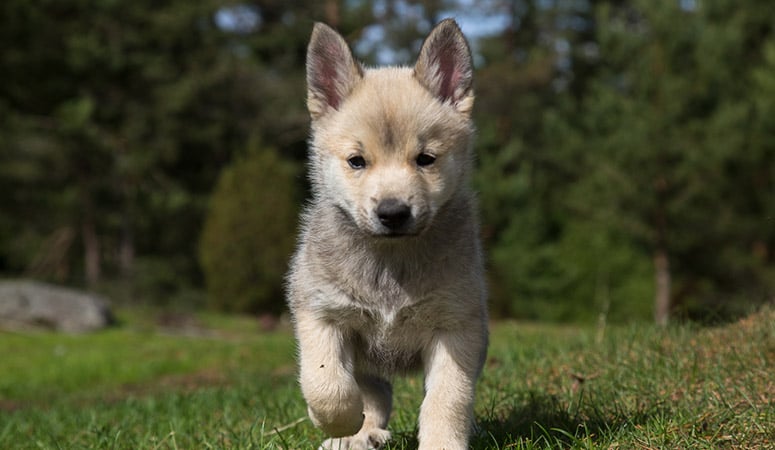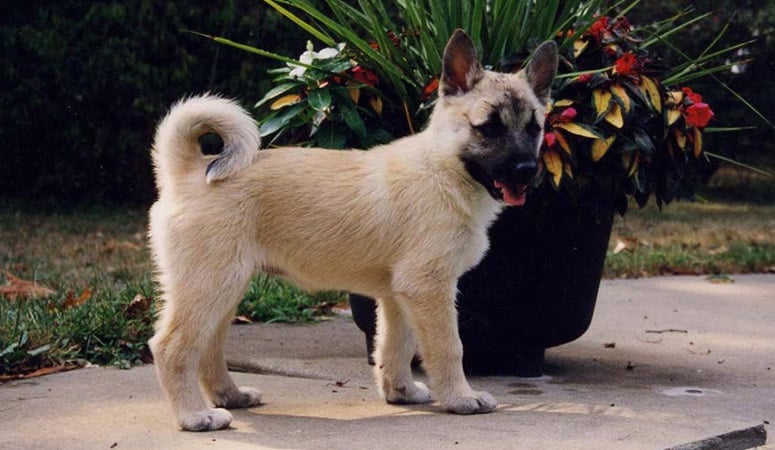Norwegian Buhund
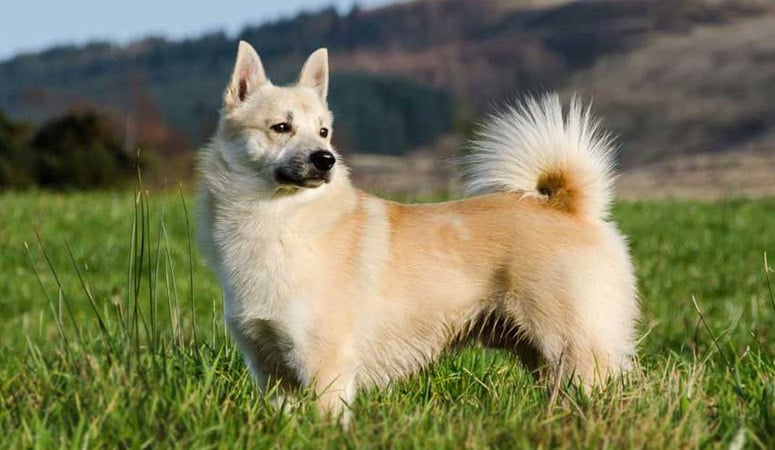
Once work dogs, Norwegian Buhunds are energetic. They need exercise frequently. When it comes to training, trainers are likely to suffer difficulties as Norwegian Buhunds are independent. However, deep pet-owner emotional connection can make the impossible happen.
| Other Names | Norsk Buhund Norwegian Sheepdog |
| Color | Black, Black and Tan, White |
| Height | Males: 17-18.5 inches. Females: 16-17.5 inches. |
| Weight | Males: 31-40 pounds. Females: 26-35 pounds. |
| Life Span | 12-15 years |
| Personality | Confident, Smart, Perceptive |
| Exercise | Energetic |
| Origin |
| Popularity | #169 |
| Groom Needs | Weekly Brushing and Seasonal Shedding |
| Kids Friendly | Yes with supervision |
| Dog Friendly | Yes with supervision |
| Watch Dog | |
| Family Dog | |
| Litter Size | 2-8 puppies |
Norwegian Buhund Pictures
Norwegian Buhund Video
Introduction
The Norwegian Buhund is extremely energetic and gets into an ill temper when it doesn’t get the chance to expend this energy. A little below the medium size class of dogs, Norwegian Buhunds pack their own weight in stock and squareness. Usually loyal and intimate with their family, but aloof to strangers, these dogs can yet be stubborn. One of their good features is their eagerness to be taught new things all year round. As spitz-type dogs, they have a dense coat and a tail that curves tightly over their backs. They are usually wheaten-colored, or rather any shade of color from pale cream to bright orange.
A standard male of this breed weighs about 30-40 pounds, in a medium-sized frame that measures to around 17-19 inches at the withers. A female Norwegian Buhund stands 16-18 inches from shoulder to paw and weighs in the range of 25-35 pounds. They belong to the Herding Group and have an average life expectancy of 12-15 years.
Living with Norwegian Buhund
It takes little efforts to groom the Norwegian Buhunds, as they have short to medium length coat. It’s not likely to get tangled, as the the hairs of Norwegian Buhund are soft and smooth. Owners can use a brush and a metal comb to groom them. Owners need to brush the Buhunds two to three times a week, and more often during some specific time. This breed sheds large amount of hairs seasonally. So owners especially need to concern about the importance of hair brushing in shedding seasons. The Norwegian Buhunds will blow coat twice a year, so owners need to brush their coat frequently during that period. The Norwegian Buhunds coat blows are like molting of birds. Their hairs will come out in clumps rather than in strands. Owners need to be patient and calm, as it’s a normal phenomenon for Buhund. Extra brushing is necessary during the twice-a-year coat blow. Though their grooming can be time-consuming in specific time, the Norwegian Buhunds are very clean and odorless. Teeth-brushing is also important. Use pet toothpaste advised by vet can be applicable.
Norwegian Buhunds are fanatic about exercising outdoor. As one of herding breeds, the Buhunds have been raised to work and herd for centuries. So that when it comes with some all-out running activities, the Buhunds can be energetic and excited. If owners keep them in an apartment for too long, the Buhunds will become unhealthy and gloomy, which bring no benefits to mental health and physical health. Owners need to spend some time to take them out for vigorous exercise. Twice-a-day all-out running is applicable to them. To keep them in optimum physical and mental health, owners are advised to interact with them by playing fetch games, ball-throwing games, and etc. This breed is fond of many atheletic activities, so they are suitable for owners who like outdoor exercise. They can be good companions in cycling, hiking, and etc, adding emotional connection between pet and owners as well.
Norwegian Buhunds are not critical about food. But as they are fond of exercising. Owners need to feed them premium-quality food. They are suitable to eat some dry kibble, whether it’s commercially manufactured or home made can be applicable to the Buhunds. If owners find it difficult to formulate a good diet for Norwegian Buhunds, it’s a advisable to ask breeders for suggestions about high-energy dog food. Puppy, adult and senior dog should be fed on appropriate amount of food the dog. Owners should feed them on account of activity level, so owners need to feed them more in all-out running days. While the Buhund are out herding livestock almost every day, owners should meet the diet need of Buhund. The Buhunds are likely to get overweight duing training period, so owners should avoid feed them that much. Appropriate treats can do good to training process, but obesity can easily occur if too much food are fed to dogs. Last but no least, dogs should be fed on clean and fresh water.
Norwegian Buhunds are basically in good health. However, some diseases are likely to occur. Eye issues, von Willebrand’s disease, hip dysplasia are common among their inherited issues. But careful breeders have screen some of their inherit diseases before a new owners adopt dogs. The health condition of an adult Norwegian Buhund can be easily evaluated even by a novice owners. When it comes to puppy Norwegian Buhunds, it’s more advisable for novice buyers to confirm the outcome of health screening. Owners need to become more responsible, experienced and active about the upcoming companionship with Norwegian Buhunds. Learn about the dangerous food for Norwegian Buhunds is of great importance. Ask vets or breeders for advice if you are not clear about the appropriate amount of dog food. To keep them mentally and physically healthy, owners need to avoid overweight and bloat problems. Take them out for some brisk walks to run off some energy. Owners will bring the Norwegian Buhunds happiness and joy if you interact with them during exercising hours. The Norwegian Buhunds will be mentally healthy when the emotional connection between owner and Norwegian Buhunds is added.
Total Annual Cost: $2889
Cost is estimated for the first year and may vary depending on many factors, such as dog food, health care, leash, collar, licensing, possible fencing, crates, training and obedience classes, dog-walking, grooming, treats, toys, flea, tick, and heart-worm meds, microchips, etc.
Norwegian Buhunds are smart, they are independent yet. To some extent, Norwegian Buhunds are easy to train. Strong independence makes it hard for the Buhunds to obey the directions trainers give. Their focus are hard to maintained. However, the Buhunds highly desire to please human. Positive reinforcement-training method and highly food-motivated approach are applicable to the training of the Buhunds. Trainers can choose to use way of clicker training, which do benefits to training process. After basic obedience training, the agility training can be a piece of cake. Perfect Buhunds can take part in some agilty competitions, which will make them proud of themself. However, any training are based on some emotional connection, as the Buhunds will be at ease around intimate human. Trainers can also take advantage of this breed’s versatility and intellect, training them to be work dog. They can be applicable to fields of service, search and police.
History
The origin of the Norwegian Buhund is often linked to the era of the Viking’s occupation of Norway, many centuries ago. Some archaeological findings have given substantial credence to this theory, although another theory opines that the Norwegian Buhund had descended from a breed of local Norwegian dogs of the spitz-type, known to have existed centuries before the Common Era. Although it isn’t exactly clear what breed the Norwegian Buhund originated from, it resembles the Icelandic Sheepdog. The Norwegian Buhund earned its feed initially as a hearing dog and as a hunting dog for deer, fox, moose, wood grouse, and other wild games. In the course of time, they migrated into the farmsteads, first as guard dogs then subsequently as herding dogs.
Before the turn of the 20th century, the Norwegian Buhund was on the brink of disappearing and was hastily being replaced by other local and exotic breeds. By the 1910s, the name Buhund was almost forgotten, not until Jon Sæland, who was a government official of the newly independent nation Norway, came to the rescue. Jon Sæland is credited with the resurgence of the breed, of which he organized the first Norwegian Buhund dog show in 1925, the first of its kind. In 1926, he had promoted the drafting of the breed standard. A native Buhund club, the Norsk Buhundklubb, was established in 1939 starting out with 42 member dogs. Soon, interest in the Norwegian Buhund began to grow outside its native home, dogs were exported to countries such as the UK, U.S, Australia, and many others. In the U.S, a breed club was founded in the 1980s, hence promoting the breed for official recognition. In 2009, the Norwegian Buhund was officially recognized by the American Kennel Club (AKC) as a member of the Herding Group.
Helpful Information
Breed Club: Norwegian Buhund Club of America
Breed Club Link: https://buhund.org/
Breed Club Rescue: NORWEGIAN BUHUND RESCUE
Breed Club Rescue Link: https://buhund.org/rescue

